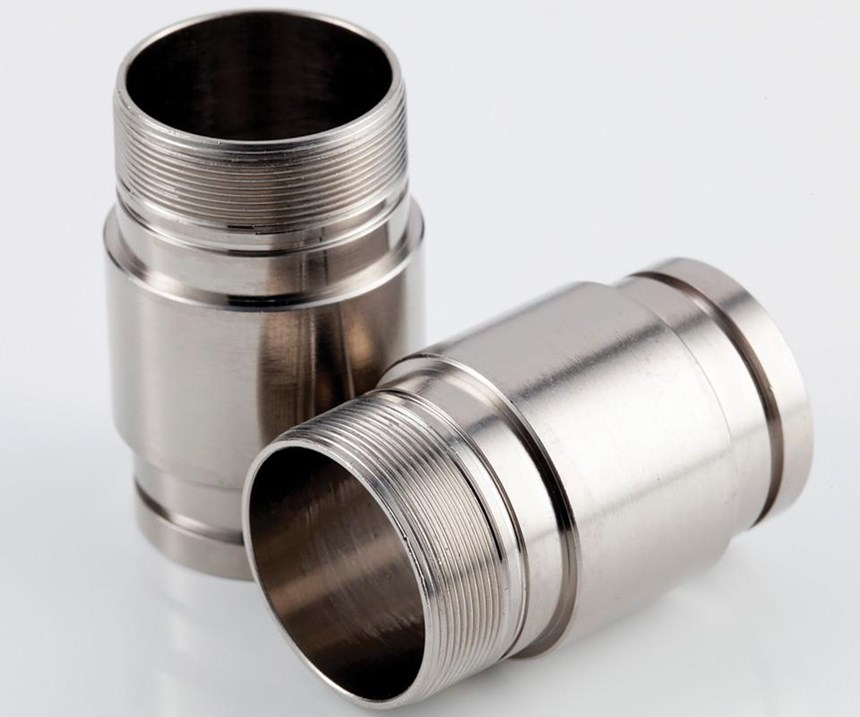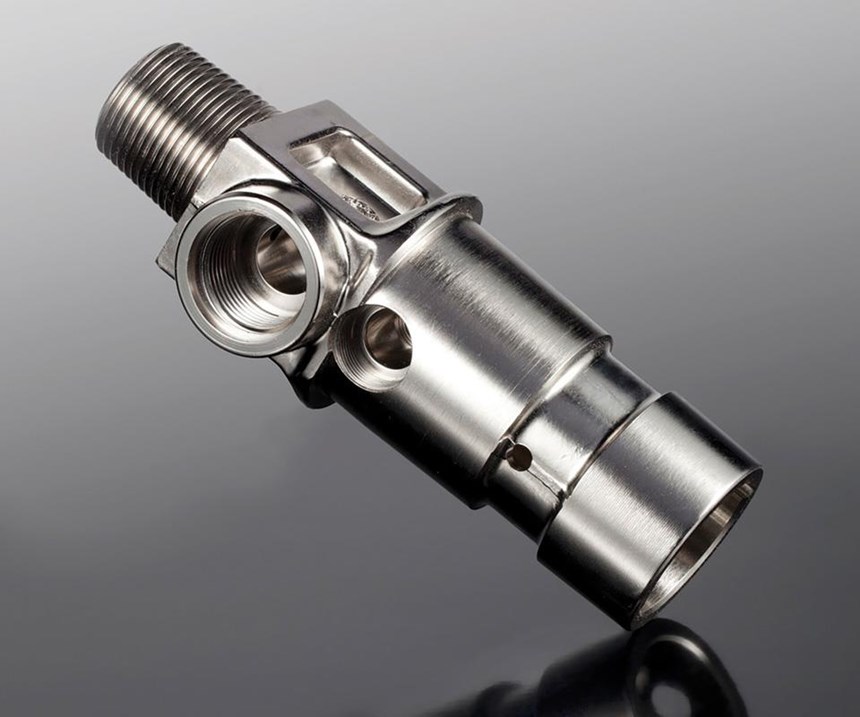Fixing Electroless Nickel Adhesion Issues
A shop plated a carburized AISI 8620 steel alloy with 15 microns of an 8-percent NiP electroless nickel deposit and acceptance by its customer. Now, the OEM requires that the shop switch to an EN deposit in the range of 5 percent. Coventya's Brad Durkin offers a solution.
For over a year, an electroplater has successfully rack plated a carburized AISI 8620 steel alloy with 15 microns of an 8-percent nickel phosphorus (NiP) electroless nickel deposit and acceptance by its customer.
But now, the OEM is requiring that the shop switch to an EN deposit in the range of 5 percent. Since changing to this EN-type deposit, the shop has seen its rejection rate increase dramatically, which requires stripping and high rework costs. When they strip and re-plate these rejected parts—again with the 5 percent deposit—they have few defects and rejects on the second processing.
They ruled out the EN chemistry being the root cause for initial failure. The reasons for rejection included a high occurance of deposit chipping, especially on the machined surfaces of the part. But overall, they saw more defects in these surfaces, including pits and blisters. The non-machined surfaces seemed less affected, except around part edges. The issue was identifying why they were having problems and how they could improve their success with the first-pass plating.
We reviewed the finisher’s process cycle, the frequency of rejections based on lots or batches processed, and their history with processing this part. The following is a summary of the areas of focus to help identify root causes.
The substrate AISI 8620 is a hardenable chromium, molybdenum, nickel, low-alloy steel often used for carburizing. The process of carburizing steel is applied to increase the carbon content at the surface, so that by suitable heat treatment, the carburized surface will be substantially harder than the core of the part. The combined process of carburizing plus hardening by thermal treatment is generally known as “case hardening,” a process designed to improve the wear characteristics of the part, which is often utilized for gears, ring gears, shafts utilized in transaxle assemblies and other tubular parts or components.
Considerations
Some considerations include the following perspectives:
The Substrate. Initially there was some question to the engineering requirement of the part—why change the deposit to a harder EN layer when carburizing and case hardening is required for the part originally plated with the 8-percent NiP alloy? In one perspective, this EN offers a sturdy base layer for the deposit and provides good corrosion protection to those surfaces. Our industry recognizes that a 4- to 6-percent range NiP alloy provides more durability and improved wear resistance characteristics over the higher phosphorus alloy in many similar types of applications. OEM testing on various deposits validated that this lower range of phosphorus would offer advantages for the application and therefore the reason it was changed for the blueprint of the part.
According to the Concise Metals Engineering Handbook, published by ASM International, 2008, this high-strength, low-alloy composition contains a range from 0.4 to 0.6 percent chromium, 0.15 to 0.25 m, 0.4 to 0.7 percent nickel and has a carbon content from 0.18 to 0.23 percent. This is still considered to be low carbon range but can provide problems from the carburizing process, since carbon and the complexity of oxides formed from these alloying elements require greater emphasis on the pickling and acid activation process in the plating sequence.
The Part. In discussion, it was also learned that the machining of this part’s surface is completed prior to the carburizing process, which has high potential for creating complex oxides that are not acid soluble. Since the EN-plated machined surfaces, which have improved surface smoothness—or lack of surface roughness—are impacted to a greater extent by adhesion loss and overall greater defects resulting, and with the greater potential for complex oxides on the surface, some greater focus to surface preparation for this case is required.
The Process Cycle and Sequence. In any plating process, the removal of oxides from the surface is critical for maximizing adhesion. The existing successful preparation cycle sequence for this part included an alkaline soak clean, an anodic electroclean, a 30-percent v/v hydrochloric acid pickle, an anodic electroclean and acid salt (sulfuric/fluoride/chloride) acid activation. This process sequence is not often typical for most ENP applicators but provided good robustness and success on this 8620 alloy with the 8-percent NiP alloy. For the 5-percent NiP alloy, the same process sequence was not working, but an important clue became obvious after the stripping and successful re-plating process with the same cycle sequence.
Rework. Strip and re-processing parts with a successful outcome indicates that the substrate surface is being modified or cleaned/activated further by the stripping process. Often, the removal of EN by the stripping action or those chemistries utilized for reworking parts often serves as an additional surface preparation step and overall added costs and loss of production efficiency.
The EN System and Resulting Deposit. The switch from an 8-percent NiP alloy to the lower phosphorus EN alloy of 5-percent P offers the benefits of a harder deposit with or without post-heat-treatment. The Knoop hardness ranges from 725 - 1100 HK100. This range provides improved wear performance for the part and proved beneficial for many wear applications and in this case, was verified by the OEM. However, our industry experience and challenge of applying a very hard “as-deposited” EN layer over hardened substrate surfaces requires more attention to the details of surface preparation. Despite the positive impact of a lower phosphorus range toward part fatigue and wear performance, other characteristics of deposit ductility and internal stresses also help to explain why there is an important emphasis toward surface preparation required.
Harder EN Deposits
Harder EN deposits offer less ductile characteristic and are more prone to brittleness in many applications. Applying these deposit types over hardened surfaces when the likelihood exists that substrates have complex oxides, as in this case, makes it more prone to experience blisters and loss
of adhesion.
Also, internal stresses from 8-percent P chemistries have a higher tensile stress tendency compared to the 5-percent P chemistries, which provide very low tensile or exhibit a compressive nature in their tendency. Experience demonstrates that in the latter situation of over-hardened part surfaces there is increased potential for marginal surface adhesion. A simple way to think about this visually would be if your hand were an EN deposit.
In this case, a high tensile stress will want your hand to “grasp” or hold on to the substrate more than a low tensile or compressive deposit, which wants to be in a “relaxed” state on the substrate surface. A low stress condition is a good characteristic for the part fatigue but only if adhesion to the substrate is optimized. Otherwise, this relaxed deposit is more likely to result in deposit blisters or poor adhesion of the layer due to the hardness of substrate and in this case, a very smooth, machined surface.
Regardless of this simple visualization, when the total stress in the coating is greater than the adhesive strength on the substrate, the layer will blister and peel. By contrast, if the total stress is very high tensile and exceeds the tensile strength of the coating, the EN deposit will spontanously crack, which is uncommon, but I have witnessed with contaminated HPEN deposit over 4340 Alloy. Internal stresses can impact ENP deposit performance where adhesion is not the best.
Success Achieved
Carburizing produces smut and scale, which can be a combination of reduced carbon and complex metal oxides that are not easily acid soluble. As a result, most EN surface preparation lines are not set up to handle these conditions effectively.
Changing the EN system with their given characteristics and deposit differences often requires a different strategical approach. In this case, incorporating an aqueous solution of alkaline permanganate into their process was effective at converting (by oxidization) the smut and scale to acid soluble forms that could be more easily removed in the plating cycle.
After alkaline soak cleaning, the process sequence incorporated a mixture of potassium permanganate (KMnO4) at 50 g/L and 100 g/L of sodium hydroxide (NaOH) operated at 90°C (194°F) for 10 minutes. With their existing process sequence following and the changeover to a 5-percent NiP alloy, the high quality returned, the high reject rate was eliminated and the customer was again satisfied with the deposit performance and output of the plating process.
Alkaline permanganate has been available to the surface finishing industry for more than five decades. The approach recognizes that for some applications scale modification is beneficial, since all oxides are not created equal and some types are less often removed by pickling than others.
There are variations on these chemistry mixtures, but some have theorized the most likely explanation for their effectiveness would appear to be that surface oxidation with permanganate is accompanied by volume changes in the transition of metallic oxides from a lower to higher valence state. This directly impacts scale by loosening the layers, which facilitates more acid attack by more standard acid pickle mixtures. Layer loosening is related to the three-layer structure of iron oxides, where it is pointed out the lowest iron oxide layer is being attacked preferentially and loosened for acid action.
Theory aside, this approach has demonstrated success more often than not in many case studies.
Brad Durkin is Director of International Product Management for Coventya. Visit Coventya.com.
Coventya Inc.
Originally published in the April 2017 issue.
Related Content
Nanotechnology Start-up Develops Gold Plating Replacement
Ag-Nano System LLC introduces a new method of electroplating based on golden silver nanoparticles aimed at replacing gold plating used in electrical circuits.
Read MoreTrivalent Chrome Overview
As the finishing industry begins to move away from the use of hexavalent chromium to trivalent chromium, what factors should finishers consider as they make new investments? Mark Schario, chief technology officer for Columbia Chemical offers a helpful overview of this complicated topic.
Read MoreProducts Finishing Reveals 2024 Qualifying Top Shops
PF reveals the qualifying shops in its annual Top Shops Benchmarking Survey — a program designed to offer shops insights into their overall performance in the industry.
Read MoreA Chromium Plating Overview
An overview of decorative and hard chromium electroplating processes.
Read MoreRead Next
Delivering Increased Benefits to Greenhouse Films
Baystar's Borstar technology is helping customers deliver better, more reliable production methods to greenhouse agriculture.
Read MoreEpisode 45: An Interview with Chandler Mancuso, MacDermid Envio Solutions
Chandler Mancuso, technical director with MacDermid Envio discusses updating your wastewater treatment system and implementing materials recycling solutions to increase efficiencies, control costs and reduce environmental impact.
Read MoreA ‘Clean’ Agenda Offers Unique Presentations in Chicago
The 2024 Parts Cleaning Conference, co-located with the International Manufacturing Technology Show, includes presentations by several speakers who are new to the conference and topics that have not been covered in past editions of this event.
Read More

























